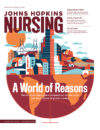In 2014, more than half of Americans reported alcohol use, with 23 percent admitting to binge drinking. That same year, 10 percent of all respondents to a survey reported illicit drug use—and twice that for those 18-25. In 2015, 52,000 U.S. deaths were blamed on opioid abuse.
The clear answer is to replace outmoded nursing curricula with a set of clinical strategies known as Screening, Brief Intervention, and Referral to Treatment (SBIRT) for substance use, write Deborah Finnell, DNS, RN, FAAN, Christine Savage, PhD, RN, FAAN, Bryan Hansen, PhD, RN, Michael Sanchez, DNP, CRNP, FNP-BC, Kathleen White, PhD, RN, FAAN, and colleagues in “Integrating Substance Use Content in an ‘Overcrowded’ Nursing Curriculum.”
And yet higher education for nurses has been too slow to embrace it.
Survey studies examining this content in nursing curricula reveal little change in the type and amount of content over the past four decades, they write. The Surgeon General has reported that substance use disorders are strongly intertwined with other medical conditions. And educated nurses are more likely to make the connection during their interactions with patients.
“There has been a large volume of primarily positive evidence supporting brief alcohol interventions,” they explain. “Subsequently, nurse leaders have called for all nurses to be knowledgeable and competent” in SBIRT, meaning that education should begin in school.
The article describes a four-phase process that guided the integration of this specialty content into a prelicensure nursing curriculum and a master’s level advanced practice nursing curriculum:
- Laying the Groundwork—Assemble a team to study current curriculum for outdated content. Provide a two-day workshop on SBIRT for faculty and nurse clinicians. “In this initial phase, we began with the end in mind. That is, our goal was to develop the knowledge and skills of faculty who would be teaching the content and to prepare students with the knowledge, skills, and abilities to provide competent care to persons across the continuum of substance use.”
- Adapting the Content to the Curriculum—“The next steps entailed developing the modules and content, beginning with documenting the purpose and learning objectives, and teaching/learning content. The team collaborated on the placement of each module in an existing course.”
- Implementing the Change
- Evaluating, Revising, and Promoting the New Content.
Publication: Nurse Educator

